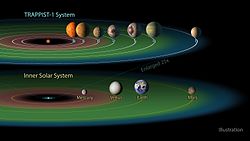Wikipedia:Main Page alternatives/(misty breeze)
Introduction · Almanac · Categories · Glossaries · Lists · Overviews · Portals · Questions · Site news · Index
Welcome to Wikipedia
| Art | Geography | History | Philosophy | Society | |||||
| Culture | Health | People | Science | Technology |
 Habitable zones of TRAPPIST-1 and the Solar System TRAPPIST-1 is a cool red dwarf star with seven known exoplanets. It lies in the constellation Aquarius about 40.66 light-years away from Earth. It has a mass of about 9% of the Sun and is estimated to be 7.6 billion years old, making it older than the Solar System. The discovery of the star was first published in 2000. Observations in 2016 from the Transiting Planets and Planetesimals Small Telescope (TRAPPIST) led to the discovery of two orbiting terrestrial planets, and five more were found in 2017. It takes the seven planets between about 1.5 and 19 days to orbit around the star. They are likely tidally locked to TRAPPIST-1, leading to permanent day on one side and night on the other. Their masses are comparable to that of Earth. Up to four of the planets orbit at distances where temperatures are suitable for the existence of liquid water (diagram pictured), and are thus potentially hospitable to life. This has drawn interest from both researchers and popular culture. (Full article...)
Recently featured:
|
|
|
|
|
 Bertoncelj at the 2015 European Games
|
|
Every page on Wikipedia is a collaborative effort. But there are some special places reserved for specific types of discussion and assistance. Find what you're looking for here:
|
|
Wikipedia is written by volunteer editors and hosted by the Wikimedia Foundation, a non-profit organization that also hosts a range of other volunteer projects:
|
|
This Wikipedia is written in English. Many other Wikipedias are available; some of the largest are listed below.
|


